fOSSa2011 sketchnotes
Download as ppt, pdf6 likes4,732 views
The document contains sketchnotes from a presentation related to FOSSa 2011. It includes links to relevant resources and mentions Nancy White as a contributor. The content is associated with Inria and Full Circ.
1 of 20
Downloaded 63 times
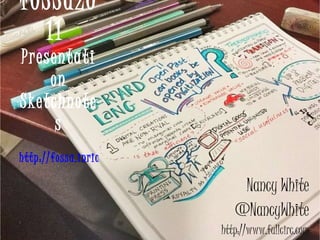
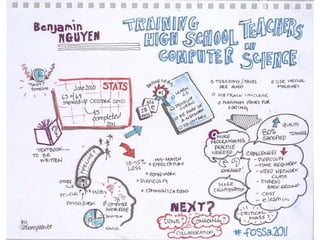

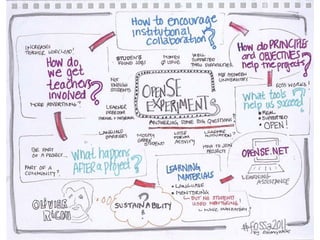
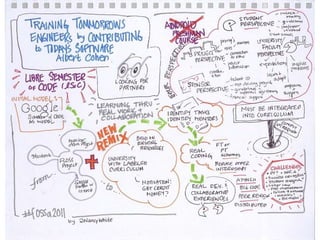
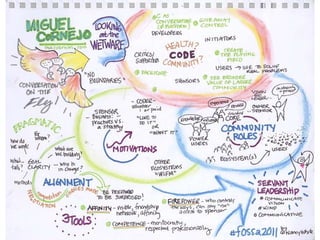
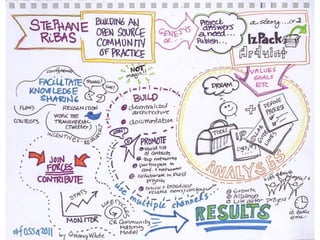

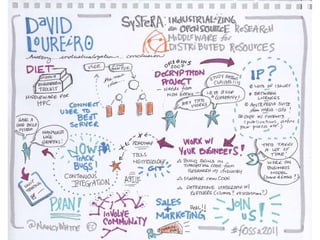
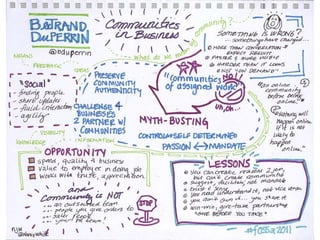
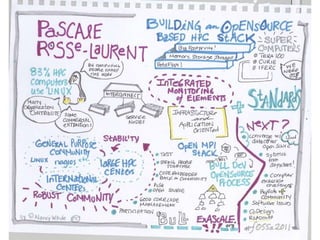
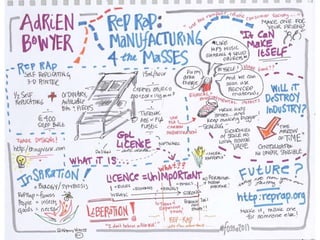

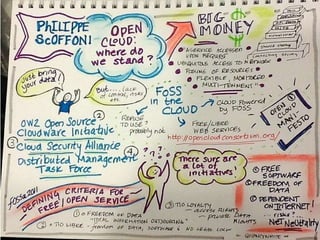

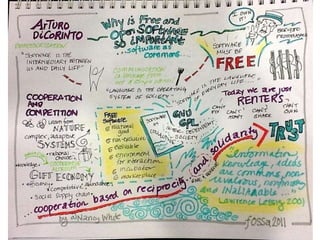
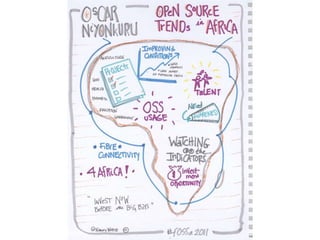


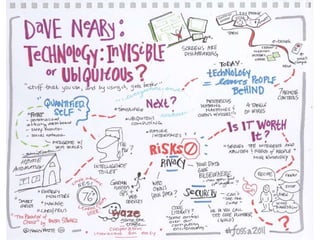
Ad
Recommended
Thinking About Visuals in Online Communities and Facilitation
Thinking About Visuals in Online Communities and FacilitationNancy Wright White
╠²
The document discusses the importance of visual communication and storytelling in enhancing collaboration and understanding during group work. It highlights various methods, such as the World Caf├® and Open Space, that utilize graphic facilitation techniques to capture and organize ideas effectively. The author also explores the potential of using online tools and images to maintain context and create shared experiences in virtual environments.Graphic Facilitation for SIKM Presentation
Graphic Facilitation for SIKM PresentationNancy Wright White
╠²
This document discusses the art of graphic facilitation, which uses visuals like diagrams, drawings, and charts to organize thoughts and capture ideas. Graphic facilitation can help groups listen, share identities, and negotiate together. It supports methods like World Cafe, Open Space, and strategic planning. While traditionally used for in-person meetings, visual techniques can also enhance phone calls and online meetings by helping participants "see" each other. Images created during discussions can establish context and create memories to continue the experience.KM Singapore 2012 Sketchnotes
KM Singapore 2012 SketchnotesNancy Wright White
╠²
This one-paragraph document provides information about sketchnotes created by Nancy White related to KM Singapore 2012. Nancy White created sketchnotes for KM Singapore 2012 and shared them online at her website http://www.fullcirc.com and on Twitter with her handle @NancyWhite.KM Singapore Graphic Facilitation Workshop Artifacts
KM Singapore Graphic Facilitation Workshop ArtifactsNancy Wright White
╠²
The document outlines a graphic facilitation workshop held in Singapore in 2012, led by Nancy White and attended by various participants. It includes descriptions of activities such as visual introductions, sketchnoting, and the use of a 'river of life' template for evaluations. Reference materials from the workshop are available online.Drawing Together Online
Drawing Together OnlineNancy Wright White
╠²
The document discusses the potential of online collaboration through visual practices and graphic work. It explores how individuals can engage in shared creative experiences by organizing thoughts and stories visually, using tools like electronic drawing apps or images. The emphasis is on breaking free from self-censorship to foster a more connected online community.Liberating Structures at Melbourne KMLF
Liberating Structures at Melbourne KMLFNancy Wright White
╠²
The document discusses Liberating Structures, innovative meeting and planning protocols that empower everyone by removing expert reliance and promoting collective idea generation. It emphasizes attributes such as inclusivity, fun, and rapid cycles for enhanced productivity and joy in group interactions. Additionally, it outlines frameworks for reflection and action to address challenges and optimize collaborative efforts.Virtual Teams and Liberating Structures Blended Session at #SFAddis
Virtual Teams and Liberating Structures Blended Session at #SFAddisNancy Wright White
╠²
The document outlines a structured approach to enhancing virtual team functionality through a game-based framework with three levels of engagement: understanding the current situation, immediate actions for improvement, and deepening practice. It includes interactive elements like 'mad tea' discussions, brainstorming to identify counterproductive behaviors, and defining minimum specifications for successful team meetings. The agenda encourages playful exploration, reflection, and the use of microstructures to foster collaboration and innovation among team members.Liberating Structures for Knowledge Sharing
Liberating Structures for Knowledge SharingNancy Wright White
╠²
The document discusses the importance of knowledge sharing and presents various interactive methods and tools for facilitating this process, drawing on the principles of liberating structures by Keith McCandless and Henri Lipmanowicz. It emphasizes two-way dialogue, collaboration, and creating an environment that encourages sharing, while exploring the challenges and misconceptions around knowledge sharing. The content also includes participant feedback and reflections from a February 2014 session focused on practical applications of these concepts.Liberating Structures Practice Session
Liberating Structures Practice SessionNancy Wright White
╠²
The document discusses the use of liberating structures in education, facilitating engagement and collaboration among participants. It outlines various interactive activities and techniques, such as impromptu networking and the '1-2-4-all' method, aimed at fostering innovation and collective problem-solving. Additionally, it emphasizes the importance of adapting educational approaches to new challenges and encourages bold thinking among educators.Ignite Seattle May 2013 - My Mysterious ║▌║▌▀Żs for a talk on Legacies
Ignite Seattle May 2013 - My Mysterious ║▌║▌▀Żs for a talk on LegaciesNancy Wright White
╠²
The document discusses plans for what someone is going to do on the 17th. It mentions @NancyWhite and includes a link to the website http://www.fullcirc.com, but provides no other context or details about the plans.Online Social Learning Practices - Benetec ║▌║▌▀Żs
Online Social Learning Practices - Benetec ║▌║▌▀ŻsNancy Wright White
╠²
The document discusses social learning, emphasizing that it occurs through peer interactions on a societal scale and can lead to changes in understanding and behavior within communities. It highlights the importance of collective intelligence, strategic team learning, and the need for effective collaboration practices in various learning environments. Additionally, it covers the role of technology in facilitating these interactions and improving communication among participants in collaborative projects.Strategic Communities of Practice
Strategic Communities of PracticeNancy Wright White
╠²
This document discusses strategic communities of practice and how to develop and sustain them. It covers basic concepts like domain, community, and practice. It emphasizes the importance of understanding stakeholder perspectives, including sponsors, facilitators/leaders, and members. It also discusses roles within communities like facilitators, network weavers, and curators. Frameworks are presented for assessing community maturity and measuring value creation through outcomes like immediate, potential, applied, and realized value. The document provides guidance on factors to consider for strategic communities of practice.This isn't what I thought it was: community in the network age
This isn't what I thought it was: community in the network ageNancy Wright White
╠²
The document discusses the evolving concept of community in the age of technology, highlighting the distinctions between individual, community, and network levels of interaction. It addresses the roles technology plays in facilitating participation and identity expression, while also examining various community structures and activities. Through case studies, such as km4dev and environmental resource networks, it showcases practical applications of technology in fostering collaboration and knowledge sharing.Facilitating Online Interaction 4 Learning Resource ║▌║▌▀Żs
Facilitating Online Interaction 4 Learning Resource ║▌║▌▀ŻsNancy Wright White
╠²
This document summarizes a workshop on using community strategies for online learning. It discusses several topics:
1. The agenda for the workshop, which included forming goals, exercises, recaps and sharing resources.
2. An exercise where participants identified questions about using communities for online learning.
3. Different types of social learning communities and their purposes, structures, and how they evolve over time.
4. The importance of clearly defining a community's purpose and allowing its structure and activities to support that purpose.
5. Various activities that can be used in social learning communities to engage members, such as meetings, projects, expert support, and relationship building.conVerge 11: Connecting for Learning: Left and right, up and down (annotated)
conVerge 11: Connecting for Learning: Left and right, up and down (annotated)Nancy Wright White
╠²
The document discusses principles for connecting groups and networks through technology. It provides 30 tips for maximizing connections at conferences, including taking notes, engaging with other attendees, providing feedback, and following up after the event. It also explores how technology has changed collaboration, the roles of facilitators, network weavers and technology stewards in connecting people, and principles of connective design for building communities and networks across platforms.Online Community Practices
Online Community PracticesNancy Wright White
╠²
The document outlines three key approaches for facilitating online communities, emphasizing the need for stability in community dynamics. It highlights the importance of community purpose and organization, along with the integration of tools and programming to enhance engagement. Additionally, it provides insights into evaluating community success through various metrics and adapting strategies based on community needs and behaviors.#Change11 MOOC Session - October 31
#Change11 MOOC Session - October 31Nancy Wright White
╠²
The document discusses the human element of change during a MOOC session on October 31. It prompts participants to reflect on their feelings about change, emphasizing the productive and pleasurable aspects of it, and invites them to engage creatively through drawing. Various resources and thoughts on managing and contributing to change in learning contexts are presented, along with references to influential figures and their ideas.fOSSa2011: Five Things About Online Community and Networks
fOSSa2011: Five Things About Online Community and NetworksNancy Wright White
╠²
The document discusses the impact of technology on community building and social interaction, highlighting new roles such as technology stewards and social artists. It emphasizes the importance of facilitating connections and active engagement within networks while addressing the need for strategic goals and feedback. The text also mentions complexity and the concept of safe-fail experiments in fostering collaboration and reciprocity.Communities, Networks and Engagement: Finding a Place for Action
Communities, Networks and Engagement: Finding a Place for ActionNancy Wright White
╠²
This document discusses communities, networks, and engagement from three perspectives: sponsors, facilitators/leaders, and members. It outlines basic vocabulary like purpose, activities, and roles. It also covers engagement strategies across different lifecycles like informal networks, formal organizations, and communities of practice. Key roles in online communities are discussed like facilitators, community leaders, and technology stewards. The importance of balancing the needs of sponsors, facilitators, and members is emphasized.Twittering or Frittering: assessing the value of a social media tool in your ...
Twittering or Frittering: assessing the value of a social media tool in your ...Nancy Wright White
╠²
The document discusses evaluating the usefulness of social media tools, particularly Twitter, in professional contexts. It outlines practical approaches for assessing social media tools, including the purpose of use, target audience, integration into existing workflows, and the risks involved. The text also emphasizes experimentation and community learning, proposing a '15 minute test' to gauge the tool's usability and effectiveness.Online Community: Still Crazy After All These Years
Online Community: Still Crazy After All These YearsNancy Wright White
╠²
This document discusses the concept of online community. It begins by questioning whether the concept of community is still relevant given changes from technology. It then examines different types of groups like individuals, small groups, and networks. It provides examples of two communities - Birdwatchers of Central Park that meets in person and KM4Dev, a knowledge sharing network. It discusses tools that communities can use like meetings, projects, expertise sharing, and cultivation. It concludes by considering how connectivity, technology landscapes, engagement, and geography may be reconfigured for online communities in the future.Why me? Why Online? Social Media and Public Health
Why me? Why Online? Social Media and Public HealthNancy Wright White
╠²
As health educators, the document discusses the importance of connecting people with information and resources both face-to-face and online. It explores how online tools can contribute to health initiatives and encourages nurturing practices that support networking and boundary spanning to access diverse sources of knowledge.Technology Stewardship Resource ║▌║▌▀Żs - Girl Scouts Leadership Conference
Technology Stewardship Resource ║▌║▌▀Żs - Girl Scouts Leadership ConferenceNancy Wright White
╠²
The document discusses technology stewardship and how communities can use technology. It provides examples of different types of community activities and orientations. It also suggests various digital tools that could support activities like meetings, projects, expertise sharing, relationships, and open-ended conversations. The goal is to help communities identify current and desired activities and select appropriate tools.Community of Practice Roles and Facilitation - Girl Scouts L&D Conference Res...
Community of Practice Roles and Facilitation - Girl Scouts L&D Conference Res...Nancy Wright White
╠²
The document discusses the concept of communities of practice (CoPs) as groups focused on shared interests and collective knowledge rather than specific tasks. It highlights the importance of engagement, trust, and participation in fostering learning and relationships among members. Additionally, it distinguishes CoPs from teams and networks, emphasizing their voluntary nature and the value of membersŌĆÖ knowledge and identity.We, Me and the Network: Girl Scouts Leadership & Development Conf Keynote
We, Me and the Network: Girl Scouts Leadership & Development Conf KeynoteNancy Wright White
╠²
The document discusses concepts around learning in networks, communities, and as individuals. It introduces the concepts of "me, we, and networks" to represent learning at the individual, community, and network levels. Key ideas that are explored include reciprocal apprenticeship, belonging, applying gifts, participation versus reification, togetherness versus separateness, and roles people take on like facilitators, community leaders, and network weavers. The document encourages reflection on how these concepts apply to contexts like Girl Scouting and how to foster learning across different levels.Where Am I Aiming? We, Me and the Network - TTIX 2010
Where Am I Aiming? We, Me and the Network - TTIX 2010Nancy Wright White
╠²
The document discusses different types of online groups - communities, networks, and social teams. Communities are defined by common interests of large groups, while networks are based on pre-existing relationships between individuals. Social teams are collections of individuals working together online to achieve a shared goal, and can be massive in scale. The document also examines polarities in online groups around togetherness/separateness and individual/group, and different roles people take on like facilitators, leaders, and content creators.IST Africa - Professional Development in a Network Era
IST Africa - Professional Development in a Network EraNancy Wright White
╠²
The document discusses the power of collaborative learning through online conferences and communities. It highlights how technology has changed the way people can collaborate by allowing participation from diverse backgrounds and locations. Online conferences offer new ways of connecting people that are more flexible and participatory compared to traditional face-to-face conferences. Participants can engage in discussions forums, live online meetings, and share knowledge through various participation levels like lurking or actively contributing. Connecting practitioners in online networks and communities allows for continued learning, support, and innovation at the boundaries of different knowledge domains.No-Code Workflows for CAD & 3D Data: Scaling AI-Driven Infrastructure
No-Code Workflows for CAD & 3D Data: Scaling AI-Driven InfrastructureSafe Software
╠²
When projects depend on fast, reliable spatial data, every minute counts.
AI Clearing needed a faster way to handle complex spatial data from drone surveys, CAD designs and 3D project models across construction sites. With FME Form, they built no-code workflows to clean, convert, integrate, and validate dozens of data formats ŌĆō cutting analysis time from 5 hours to just 30 minutes.
Join us, our partner Globema, and customer AI Clearing to see how they:
-Automate processing of 2D, 3D, drone, spatial, and non-spatial data
-Analyze construction progress 10x faster and with fewer errors
-Handle diverse formats like DWG, KML, SHP, and PDF with ease
-Scale their workflows for international projects in solar, roads, and pipelines
If you work with complex data, join us to learn how to optimize your own processes and transform your results with FME.Viral>Wondershare Filmora 14.5.18.12900 Crack Free Download
Viral>Wondershare Filmora 14.5.18.12900 Crack Free DownloadPuppy jhon
╠²
Ō×Ī ¤īŹ¤ō▒¤æēCOPY & PASTE LINK¤æē¤æē¤æē Ō׿ Ō׿Ō׿ https://drfiles.net/
Wondershare Filmora Crack is a user-friendly video editing software designed for both beginners and experienced users.
More Related Content
More from Nancy Wright White (20)
Liberating Structures for Knowledge Sharing
Liberating Structures for Knowledge SharingNancy Wright White
╠²
The document discusses the importance of knowledge sharing and presents various interactive methods and tools for facilitating this process, drawing on the principles of liberating structures by Keith McCandless and Henri Lipmanowicz. It emphasizes two-way dialogue, collaboration, and creating an environment that encourages sharing, while exploring the challenges and misconceptions around knowledge sharing. The content also includes participant feedback and reflections from a February 2014 session focused on practical applications of these concepts.Liberating Structures Practice Session
Liberating Structures Practice SessionNancy Wright White
╠²
The document discusses the use of liberating structures in education, facilitating engagement and collaboration among participants. It outlines various interactive activities and techniques, such as impromptu networking and the '1-2-4-all' method, aimed at fostering innovation and collective problem-solving. Additionally, it emphasizes the importance of adapting educational approaches to new challenges and encourages bold thinking among educators.Ignite Seattle May 2013 - My Mysterious ║▌║▌▀Żs for a talk on Legacies
Ignite Seattle May 2013 - My Mysterious ║▌║▌▀Żs for a talk on LegaciesNancy Wright White
╠²
The document discusses plans for what someone is going to do on the 17th. It mentions @NancyWhite and includes a link to the website http://www.fullcirc.com, but provides no other context or details about the plans.Online Social Learning Practices - Benetec ║▌║▌▀Żs
Online Social Learning Practices - Benetec ║▌║▌▀ŻsNancy Wright White
╠²
The document discusses social learning, emphasizing that it occurs through peer interactions on a societal scale and can lead to changes in understanding and behavior within communities. It highlights the importance of collective intelligence, strategic team learning, and the need for effective collaboration practices in various learning environments. Additionally, it covers the role of technology in facilitating these interactions and improving communication among participants in collaborative projects.Strategic Communities of Practice
Strategic Communities of PracticeNancy Wright White
╠²
This document discusses strategic communities of practice and how to develop and sustain them. It covers basic concepts like domain, community, and practice. It emphasizes the importance of understanding stakeholder perspectives, including sponsors, facilitators/leaders, and members. It also discusses roles within communities like facilitators, network weavers, and curators. Frameworks are presented for assessing community maturity and measuring value creation through outcomes like immediate, potential, applied, and realized value. The document provides guidance on factors to consider for strategic communities of practice.This isn't what I thought it was: community in the network age
This isn't what I thought it was: community in the network ageNancy Wright White
╠²
The document discusses the evolving concept of community in the age of technology, highlighting the distinctions between individual, community, and network levels of interaction. It addresses the roles technology plays in facilitating participation and identity expression, while also examining various community structures and activities. Through case studies, such as km4dev and environmental resource networks, it showcases practical applications of technology in fostering collaboration and knowledge sharing.Facilitating Online Interaction 4 Learning Resource ║▌║▌▀Żs
Facilitating Online Interaction 4 Learning Resource ║▌║▌▀ŻsNancy Wright White
╠²
This document summarizes a workshop on using community strategies for online learning. It discusses several topics:
1. The agenda for the workshop, which included forming goals, exercises, recaps and sharing resources.
2. An exercise where participants identified questions about using communities for online learning.
3. Different types of social learning communities and their purposes, structures, and how they evolve over time.
4. The importance of clearly defining a community's purpose and allowing its structure and activities to support that purpose.
5. Various activities that can be used in social learning communities to engage members, such as meetings, projects, expert support, and relationship building.conVerge 11: Connecting for Learning: Left and right, up and down (annotated)
conVerge 11: Connecting for Learning: Left and right, up and down (annotated)Nancy Wright White
╠²
The document discusses principles for connecting groups and networks through technology. It provides 30 tips for maximizing connections at conferences, including taking notes, engaging with other attendees, providing feedback, and following up after the event. It also explores how technology has changed collaboration, the roles of facilitators, network weavers and technology stewards in connecting people, and principles of connective design for building communities and networks across platforms.Online Community Practices
Online Community PracticesNancy Wright White
╠²
The document outlines three key approaches for facilitating online communities, emphasizing the need for stability in community dynamics. It highlights the importance of community purpose and organization, along with the integration of tools and programming to enhance engagement. Additionally, it provides insights into evaluating community success through various metrics and adapting strategies based on community needs and behaviors.#Change11 MOOC Session - October 31
#Change11 MOOC Session - October 31Nancy Wright White
╠²
The document discusses the human element of change during a MOOC session on October 31. It prompts participants to reflect on their feelings about change, emphasizing the productive and pleasurable aspects of it, and invites them to engage creatively through drawing. Various resources and thoughts on managing and contributing to change in learning contexts are presented, along with references to influential figures and their ideas.fOSSa2011: Five Things About Online Community and Networks
fOSSa2011: Five Things About Online Community and NetworksNancy Wright White
╠²
The document discusses the impact of technology on community building and social interaction, highlighting new roles such as technology stewards and social artists. It emphasizes the importance of facilitating connections and active engagement within networks while addressing the need for strategic goals and feedback. The text also mentions complexity and the concept of safe-fail experiments in fostering collaboration and reciprocity.Communities, Networks and Engagement: Finding a Place for Action
Communities, Networks and Engagement: Finding a Place for ActionNancy Wright White
╠²
This document discusses communities, networks, and engagement from three perspectives: sponsors, facilitators/leaders, and members. It outlines basic vocabulary like purpose, activities, and roles. It also covers engagement strategies across different lifecycles like informal networks, formal organizations, and communities of practice. Key roles in online communities are discussed like facilitators, community leaders, and technology stewards. The importance of balancing the needs of sponsors, facilitators, and members is emphasized.Twittering or Frittering: assessing the value of a social media tool in your ...
Twittering or Frittering: assessing the value of a social media tool in your ...Nancy Wright White
╠²
The document discusses evaluating the usefulness of social media tools, particularly Twitter, in professional contexts. It outlines practical approaches for assessing social media tools, including the purpose of use, target audience, integration into existing workflows, and the risks involved. The text also emphasizes experimentation and community learning, proposing a '15 minute test' to gauge the tool's usability and effectiveness.Online Community: Still Crazy After All These Years
Online Community: Still Crazy After All These YearsNancy Wright White
╠²
This document discusses the concept of online community. It begins by questioning whether the concept of community is still relevant given changes from technology. It then examines different types of groups like individuals, small groups, and networks. It provides examples of two communities - Birdwatchers of Central Park that meets in person and KM4Dev, a knowledge sharing network. It discusses tools that communities can use like meetings, projects, expertise sharing, and cultivation. It concludes by considering how connectivity, technology landscapes, engagement, and geography may be reconfigured for online communities in the future.Why me? Why Online? Social Media and Public Health
Why me? Why Online? Social Media and Public HealthNancy Wright White
╠²
As health educators, the document discusses the importance of connecting people with information and resources both face-to-face and online. It explores how online tools can contribute to health initiatives and encourages nurturing practices that support networking and boundary spanning to access diverse sources of knowledge.Technology Stewardship Resource ║▌║▌▀Żs - Girl Scouts Leadership Conference
Technology Stewardship Resource ║▌║▌▀Żs - Girl Scouts Leadership ConferenceNancy Wright White
╠²
The document discusses technology stewardship and how communities can use technology. It provides examples of different types of community activities and orientations. It also suggests various digital tools that could support activities like meetings, projects, expertise sharing, relationships, and open-ended conversations. The goal is to help communities identify current and desired activities and select appropriate tools.Community of Practice Roles and Facilitation - Girl Scouts L&D Conference Res...
Community of Practice Roles and Facilitation - Girl Scouts L&D Conference Res...Nancy Wright White
╠²
The document discusses the concept of communities of practice (CoPs) as groups focused on shared interests and collective knowledge rather than specific tasks. It highlights the importance of engagement, trust, and participation in fostering learning and relationships among members. Additionally, it distinguishes CoPs from teams and networks, emphasizing their voluntary nature and the value of membersŌĆÖ knowledge and identity.We, Me and the Network: Girl Scouts Leadership & Development Conf Keynote
We, Me and the Network: Girl Scouts Leadership & Development Conf KeynoteNancy Wright White
╠²
The document discusses concepts around learning in networks, communities, and as individuals. It introduces the concepts of "me, we, and networks" to represent learning at the individual, community, and network levels. Key ideas that are explored include reciprocal apprenticeship, belonging, applying gifts, participation versus reification, togetherness versus separateness, and roles people take on like facilitators, community leaders, and network weavers. The document encourages reflection on how these concepts apply to contexts like Girl Scouting and how to foster learning across different levels.Where Am I Aiming? We, Me and the Network - TTIX 2010
Where Am I Aiming? We, Me and the Network - TTIX 2010Nancy Wright White
╠²
The document discusses different types of online groups - communities, networks, and social teams. Communities are defined by common interests of large groups, while networks are based on pre-existing relationships between individuals. Social teams are collections of individuals working together online to achieve a shared goal, and can be massive in scale. The document also examines polarities in online groups around togetherness/separateness and individual/group, and different roles people take on like facilitators, leaders, and content creators.IST Africa - Professional Development in a Network Era
IST Africa - Professional Development in a Network EraNancy Wright White
╠²
The document discusses the power of collaborative learning through online conferences and communities. It highlights how technology has changed the way people can collaborate by allowing participation from diverse backgrounds and locations. Online conferences offer new ways of connecting people that are more flexible and participatory compared to traditional face-to-face conferences. Participants can engage in discussions forums, live online meetings, and share knowledge through various participation levels like lurking or actively contributing. Connecting practitioners in online networks and communities allows for continued learning, support, and innovation at the boundaries of different knowledge domains.Twittering or Frittering: assessing the value of a social media tool in your ...
Twittering or Frittering: assessing the value of a social media tool in your ...Nancy Wright White
╠²
Community of Practice Roles and Facilitation - Girl Scouts L&D Conference Res...
Community of Practice Roles and Facilitation - Girl Scouts L&D Conference Res...Nancy Wright White
╠²
Recently uploaded (20)
No-Code Workflows for CAD & 3D Data: Scaling AI-Driven Infrastructure
No-Code Workflows for CAD & 3D Data: Scaling AI-Driven InfrastructureSafe Software
╠²
When projects depend on fast, reliable spatial data, every minute counts.
AI Clearing needed a faster way to handle complex spatial data from drone surveys, CAD designs and 3D project models across construction sites. With FME Form, they built no-code workflows to clean, convert, integrate, and validate dozens of data formats ŌĆō cutting analysis time from 5 hours to just 30 minutes.
Join us, our partner Globema, and customer AI Clearing to see how they:
-Automate processing of 2D, 3D, drone, spatial, and non-spatial data
-Analyze construction progress 10x faster and with fewer errors
-Handle diverse formats like DWG, KML, SHP, and PDF with ease
-Scale their workflows for international projects in solar, roads, and pipelines
If you work with complex data, join us to learn how to optimize your own processes and transform your results with FME.Viral>Wondershare Filmora 14.5.18.12900 Crack Free Download
Viral>Wondershare Filmora 14.5.18.12900 Crack Free DownloadPuppy jhon
╠²
Ō×Ī ¤īŹ¤ō▒¤æēCOPY & PASTE LINK¤æē¤æē¤æē Ō׿ Ō׿Ō׿ https://drfiles.net/
Wondershare Filmora Crack is a user-friendly video editing software designed for both beginners and experienced users.
Reducing Conflicts and Increasing Safety Along the Cycling Networks of East-F...
Reducing Conflicts and Increasing Safety Along the Cycling Networks of East-F...Safe Software
╠²
In partnership with the Belgian Province of East-Flanders this project aimed to reduce conflicts and increase safety along a cycling route between the cities of Oudenaarde and Ghent. To achieve this goal, the current cycling network data needed some extra key information, including: Speed limits for segments, Access restrictions for different users (pedestrians, cyclists, motor vehicles, etc.), Priority rules at intersections. Using a 360┬░ camera and GPS mounted on a measuring bicycle, we collected images of traffic signs and ground markings along the cycling lanes building up mobile mapping data. Image recognition technologies identified the road signs, creating a dataset with their locations and codes. The data processing entailed three FME workspaces. These included identifying valid intersections with other networks (e.g., roads, railways), creating a topological network between segments and intersections and linking road signs to segments and intersections based on proximity and orientation. Additional features, such as speed zones, inheritance of speed and access to neighbouring segments were also implemented to further enhance the data. The final results were visualized in ArcGIS, enabling analysis for the end users. The project provided them with key insights, including statistics on accessible road segments, speed limits, and intersection priorities. These will make the cycling paths more safe and uniform, by reducing conflicts between users.Down the Rabbit Hole ŌĆō Solving 5 Training Roadblocks
Down the Rabbit Hole ŌĆō Solving 5 Training RoadblocksRustici Software
╠²
Feeling stuck in the Matrix of your training technologies? YouŌĆÖre not alone. Managing your training catalog, wrangling LMSs and delivering content across different tools and audiences can feel like dodging digital bullets. At some point, you hit a fork in the road: Keep patching things up as issues pop upŌĆ” or follow the rabbit hole to the root of the problems.
Good news, weŌĆÖve already been down that rabbit hole. Peter Overton and Cameron Gray of Rustici Software are here to share what we found. In this webinar, weŌĆÖll break down 5 training roadblocks in delivery and management and show you how theyŌĆÖre easier to fix than you might think.AI vs Human Writing: Can You Tell the Difference?
AI vs Human Writing: Can You Tell the Difference?Shashi Sathyanarayana, Ph.D
╠²
This slide illustrates a side-by-side comparison between human-written, AI-written, and ambiguous content. It highlights subtle cues that help readers assess authenticity, raising essential questions about the future of communication, trust, and thought leadership in the age of generative AI.Securing Account Lifecycles in the Age of Deepfakes.pptx
Securing Account Lifecycles in the Age of Deepfakes.pptxFIDO Alliance
╠²
Securing Account Lifecycles in the Age of DeepfakesŌĆ£From Enterprise to Makers: Driving Vision AI Innovation at the Extreme Edge,...
ŌĆ£From Enterprise to Makers: Driving Vision AI Innovation at the Extreme Edge,...Edge AI and Vision Alliance
╠²
For the full video of this presentation, please visit: https://www.edge-ai-vision.com/2025/06/from-enterprise-to-makers-driving-vision-ai-innovation-at-the-extreme-edge-a-presentation-from-sony-semiconductor-solutions/
Amir Servi, Edge Deep Learning Product Manager at Sony Semiconductor Solutions, presents the ŌĆ£From Enterprise to Makers: Driving Vision AI Innovation at the Extreme EdgeŌĆØ tutorial at the May 2025 Embedded Vision Summit.
SonyŌĆÖs unique integrated sensor-processor technology is enabling ultra-efficient intelligence directly at the image source, transforming vision AI for enterprises and developers alike. In this presentation, Servi showcases how the AITRIOS platform simplifies vision AI for enterprises with tools for large-scale deployments and model management.
Servi also highlights his companyŌĆÖs collaboration with Ultralytics and Raspberry Pi, which brings YOLO models to the developer community, empowering grassroots innovation. Whether youŌĆÖre scaling vision AI for industry or experimenting with cutting-edge tools, this presentation will demonstrate how Sony is accelerating high-performance, energy-efficient vision AI for all.Can We Use Rust to Develop Extensions for PostgreSQL? (POSETTE: An Event for ...
Can We Use Rust to Develop Extensions for PostgreSQL? (POSETTE: An Event for ...NTT DATA Technology & Innovation
╠²
Can We Use Rust to Develop Extensions for PostgreSQL?
(POSETTE: An Event for Postgres 2025)
June 11, 2025
Shinya Kato
NTT DATA Japan CorporationData Validation and System Interoperability
Data Validation and System InteroperabilitySafe Software
╠²
A non-profit human services agency with specialized health record and billing systems. Challenges solved include access control integrations from employee electronic HR records, multiple regulations compliance, data migrations, benefits enrollments, payroll processing, and automated reporting for business intelligence and analysis.MuleSoft for AgentForce : Topic Center and API Catalog
MuleSoft for AgentForce : Topic Center and API Catalogshyamraj55
╠²
This presentation dives into how MuleSoft empowers AgentForce with organized API discovery and streamlined integration using Topic Center and the API Catalog. Learn how these tools help structure APIs around business needs, improve reusability, and simplify collaboration across teams. Ideal for developers, architects, and business stakeholders looking to build a connected and scalable API ecosystem within AgentForce.FIDO Seminar: Authentication for a Billion Consumers - Amazon.pptx
FIDO Seminar: Authentication for a Billion Consumers - Amazon.pptxFIDO Alliance
╠²
FIDO Seminar: Authentication for a Billion Consumers - AmazonEdge-banding-machines-edgeteq-s-200-en-.pdf
Edge-banding-machines-edgeteq-s-200-en-.pdfAmirStern2
╠²
ū×ūøūĢūĀū¬ ū¦ūĀūśūÖūØ ūöū×ū¬ūÉūÖū×ūö ū£ūĀūÆū©ūÖūĢū¬ ū¦ūśūĀūĢū¬ ūÉūĢ ūÆūōūĢū£ūĢū¬ (ūøū×ūøūĢūĀū¬ ūÆūÖūæūĢūÖ).
ū×ūōūæūÖū¦ūö ū¦ūĀūśūÖūØ ū×ūÆū£ūÖū£ ūÉūĢ ūżūĪūÖūØ, ūóūō ūóūĢūæūÖ ū¦ūĀūś ŌĆō 3 ū×"ū× ūĢūóūĢūæūÖ ūŚūĢū×ū© ūóūō 40 ū×"ū×. ūæū¦ū© ū×ū×ūĢūŚū®ūæ ūöū×ū¬ū©ūÖūó ūóū£ ū¬ū¦ū£ūĢū¬, ūĢū×ūĀūĢūóūÖūØ ū×ūÉūĪūÖūæūÖūÖūØ ū¬ūóū®ūÖūÖū¬ūÖūÖūØ ūøū×ūĢ ūæū×ūøūĢūĀūĢū¬ ūöūÆūōūĢū£ūĢū¬.FIDO Seminar: Targeting Trust: The Future of Identity in the Workforce.pptx
FIDO Seminar: Targeting Trust: The Future of Identity in the Workforce.pptxFIDO Alliance
╠²
FIDO Seminar: Targeting Trust: The Future of Identity in the WorkforceOpenACC and Open Hackathons Monthly Highlights June 2025
OpenACC and Open Hackathons Monthly Highlights June 2025OpenACC
╠²
The OpenACC organization focuses on enhancing parallel computing skills and advancing interoperability in scientific applications through hackathons and training. The upcoming 2025 Open Accelerated Computing Summit (OACS) aims to explore the convergence of AI and HPC in scientific computing and foster knowledge sharing. This year's OACS welcomes talk submissions from a variety of topics, from Using Standard Language Parallelism to Computer Vision Applications. The document also highlights several open hackathons, a call to apply for NVIDIA Academic Grant Program and resources for optimizing scientific applications using OpenACC directives.FIDO Seminar: New Data: Passkey Adoption in the Workforce.pptx
FIDO Seminar: New Data: Passkey Adoption in the Workforce.pptxFIDO Alliance
╠²
FIDO Seminar: New Data: Passkey Adoption in the WorkforceAudGram Review: Build Visually Appealing, AI-Enhanced Audiograms to Engage Yo...
AudGram Review: Build Visually Appealing, AI-Enhanced Audiograms to Engage Yo...SOFTTECHHUB
╠²
AudGram changes everything by bridging the gap between your audio content and the visual engagement your audience craves. This cloud-based platform transforms your existing audio into scroll-stopping visual content that performs across all social media platforms.
War_And_Cyber_3_Years_Of_Struggle_And_Lessons_For_Global_Security.pdf
War_And_Cyber_3_Years_Of_Struggle_And_Lessons_For_Global_Security.pdfbiswajitbanerjee38
╠²
Russia is one of the most aggressive nations when it comes to state coordinated cyberattacksŌĆŖŌĆöŌĆŖand Ukraine has been at the center of their crosshairs for 3 years. This report, provided the State Service of Special Communications and Information Protection of Ukraine contains an incredible amount of cybersecurity insights, showcasing the coordinated aggressive cyberwarfare campaigns of Russia against Ukraine.
It brings to the forefront that understanding your adversary, especially an aggressive nation state, is important for cyber defense. Knowing their motivations, capabilities, and tactics becomes an advantage when allocating resources for maximum impact.
Intelligence shows Russia is on a cyber rampage, leveraging FSB, SVR, and GRU resources to professionally target UkraineŌĆÖs critical infrastructures, military, and international diplomacy support efforts.
The number of total incidents against Ukraine, originating from Russia, has steadily increased from 1350 in 2021 to 4315 in 2024, but the number of actual critical incidents has been managed down from a high of 1048 in 2022 to a mere 59 in 2024ŌĆŖŌĆöŌĆŖshowcasing how the rapid detection and response to cyberattacks has been impacted by UkraineŌĆÖs improved cyber resilience.
Even against a much larger adversary, Ukraine is showcasing outstanding cybersecurity, enabled by strong strategies and sound tactics. There are lessons to learn for any enterprise that could potentially be targeted by aggressive nation states.
Definitely worth the read!Raman Bhaumik - Passionate Tech Enthusiast
Raman Bhaumik - Passionate Tech EnthusiastRaman Bhaumik
╠²
A Junior Software Developer with a flair for innovation, Raman Bhaumik excels in delivering scalable web solutions. With three years of experience and a solid foundation in Java, Python, JavaScript, and SQL, she has streamlined task tracking by 20% and improved application stability.ŌĆ£From Enterprise to Makers: Driving Vision AI Innovation at the Extreme Edge,...
ŌĆ£From Enterprise to Makers: Driving Vision AI Innovation at the Extreme Edge,...Edge AI and Vision Alliance
╠²
Can We Use Rust to Develop Extensions for PostgreSQL? (POSETTE: An Event for ...
Can We Use Rust to Develop Extensions for PostgreSQL? (POSETTE: An Event for ...NTT DATA Technology & Innovation
╠²
Ad
